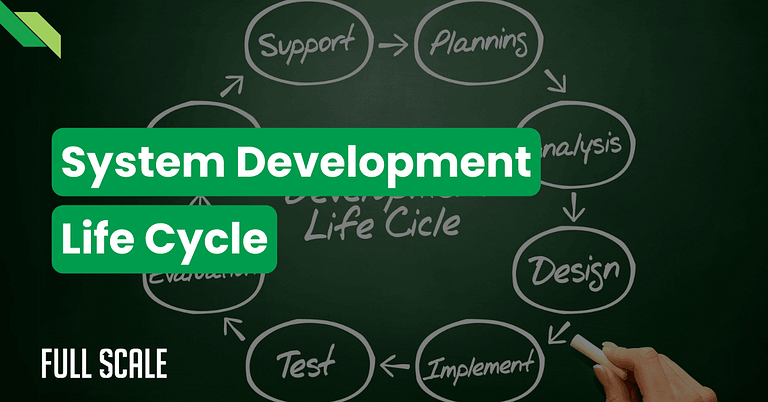Last Updated on 2025-03-04
Software development demands a structured approach for optimal results. The System Development Life Cycle (SDLC) provides this framework, guiding teams through each project phase.
Recent insights reveal SDLC’s growing importance. A 2023 Gartner report shows that 78% of successful IT projects use formal SDLC methodologies. Additionally, companies adopting SDLC practices report a 35% reduction in project failures.
Implementing SDLC can transform your development process. It offers a roadmap for creating high-quality software efficiently. By following SDLC stages, teams can minimize risks, optimize resources, and deliver products that truly meet user needs.
Let’s explore how SDLC can revolutionize your software development process.
SDLC Unveiled
The System Development Life Cycle is a comprehensive framework for software creation. It spans from initial concept to final deployment and maintenance. SDLC ensures efficient resource allocation and timely project completion.
Recent statistics highlight SDLC’s impact:
- 62% of companies using SDLC report improved project predictability (PMI, 2023)
- SDLC adoption leads to a 40% decrease in post-release defects (IBM, 2023)
- Organizations using SDLC methodologies see a 25% increase in customer satisfaction (Forrester, 2023)
SDLC’s structured approach minimizes risks and enhances quality control. It provides a clear roadmap for project managers and developers alike.
SDLC’s Core Purpose
The primary purpose of SDLC is to deliver high-quality software that meets user needs efficiently. It achieves this through several key functions:
Risk Mitigation
SDLC helps identify potential issues early in the development process. This proactive approach prevents costly errors later, saving time and resources.
Enhanced Project Management
By providing a clear framework, SDLC improves project organization. It facilitates better resource allocation, timeline management, and progress tracking.
Quality Assurance
Each SDLC phase includes specific quality checks. This ensures the final product meets or exceeds user expectations and industry standards.
Improved Communication
SDLC promotes clear communication among team members and stakeholders. It provides a common language and structure for discussing project progress and goals.
Understanding SDLC’s purpose is crucial for leveraging its full potential. Let’s now explore its scope and goals.
SDLC’s Scope and Goals Defined
The scope and goals of the system development life cycle form the foundation of its effectiveness. They define the boundaries of the development process and set clear objectives for project success.
SDLC’s Scope
SDLC’s scope encompasses the entire software development journey. It starts with the initial concept and extends to post-deployment maintenance. This comprehensive approach ensures no aspect of development is overlooked.
1. Requirements gathering and analysis: This involves collecting and documenting user needs and system requirements. It sets the foundation for the entire project.
2. System design and architecture: Here, the overall structure of the software is planned. This includes database design, user interface layouts, and system integrations.
3. Coding and implementation: This is where the actual software is built, following the design specifications.
4. Testing and quality assurance: Rigorous testing ensures the software meets all requirements and functions as intended.
5. Deployment and user training: This involves releasing the software and preparing users to utilize it effectively.
6. Maintenance and updates: Ongoing support and improvements keep the software relevant and efficient over time.
By covering all these areas, the system development life cycle ensures a holistic approach to software development.
System Development Life Cycle’s Goals
SDLC aims to achieve several critical objectives:
1. Efficient Resource Utilization: The system development life cycle optimizes the use of time, money, and human resources. This efficiency is crucial for project success and business profitability.
2. Stakeholder Satisfaction: SDLC ensures that the final product aligns with user needs and business objectives by involving stakeholders at various stages.
3. Continuous Improvement: The system development life cycle facilitates the ongoing refinement of the development process. Teams can learn from each project and enhance their methodologies over time.
4. Timely Delivery: The structured approach of SDLC helps keep projects on schedule. It provides clear milestones and deadlines for each phase.
5. Cost Control: By identifying issues early and optimizing resources, SDLC helps manage project costs effectively.
Understanding SDLC’s scope and goals is essential for successful implementation. Next, let’s explore various system development life cycle models.
4 SDLC Models Explored
Several system development life cycle models exist, each suited to different project types. The choice of model can significantly impact project success. Let’s examine some popular options:
1. Waterfall: Linear Precision
The Waterfall model follows a sequential approach. Each phase must be completed before moving to the next.
Best for: Projects with well-defined, stable requirements. It works well for small to medium-sized projects where changes are unlikely.
Advantages:
- Clear structure and milestones
- Easy to manage and control
- Well-documented process
2. Agile: Flexible and Iterative
Agile emphasizes flexibility and continuous improvement. Teams work in short sprints, delivering functional software incrementally.
Best for: Projects with evolving requirements or where rapid delivery is crucial. It’s ideal for innovative products in dynamic markets.
Advantages:
- Adapts easily to changing requirements
- Promotes frequent stakeholder involvement
- Delivers working software quickly
3. Spiral: Risk-Driven Development
The Spiral model combines elements of both Waterfall and prototyping. Each iteration involves thorough risk analysis.
Best for: Large, high-risk projects with complex requirements. It’s suitable for projects where safety is critical.
Advantages:
- Strong focus on risk assessment
- Allows for mid-project changes
- Suits complex, long-term projects
4. V-Model: Verification and Validation
Also known as the Verification and Validation model, it emphasizes parallel testing activities.
Best for: Projects requiring rigorous testing at each stage. It’s ideal for critical systems where reliability is paramount.
Advantages:
- Early test planning
- Highly disciplined approach
- Clear responsibility assignment
While we’ve discussed the 7 stages of the system development life cycle, some organizations use a simplified 5 phases of the system development life cycle. This condensed version typically combines some stages but still covers the essential aspects of software development.
Choosing the right model depends on project complexity and team expertise. Consider your project’s unique needs when selecting an SDLC model.
Now, let’s dive into the core stages of the system development life cycle.
7 SDLC Stages Demystified
SDLC comprises seven essential stages. Each stage builds upon the previous one, creating a cohesive development process.
To help you visualize the process, let’s place the steps of the system development life cycle (SDLC) in order, with the first step at the top:
- Planning
- Analysis
- Design
- Implementation
- Testing
- Deployment
- Maintenance
This ordered list clearly shows the progression of the system development life cycle stages, emphasizing the importance of following each step sequentially.
1. Planning: Foundation Setting
Planning sets the stage for project success. It involves defining objectives, conducting feasibility studies, and estimating resources. A well-planned project is more likely to succeed.
Recent data underscores the importance of planning. Projects with rigorous planning are 50% more likely to meet deadlines and budgets (PMI, 2023).
Best Practices:
- Clearly define project scope and objectives
- Involve all key stakeholders in the planning process
- Conduct a thorough risk assessment
2. Analysis: Need Understanding
During analysis, teams gather detailed requirements from stakeholders. This stage involves user interviews, system analysis, and requirement documentation. Thorough analysis leads to better outcomes.
A 2023 Gartner study found that comprehensive requirement analysis reduces mid-project changes by 35%.
Best Practices:
- Use multiple techniques for gathering requirements (interviews, surveys, workshops)
- Prioritize requirements based on business value and feasibility
- Create detailed use cases and user stories
3. Design: Blueprint Crafting
The design phase translates requirements into a system blueprint. It covers system architecture, user interfaces, and security protocols. A solid design lays the groundwork for efficient implementation.
IBM reports that well-documented design phases result in 40% fewer defects in the final product.
Best Practices:
- Create detailed system architecture and database designs
- Develop user interface mockups and prototypes
- Conduct design reviews with stakeholders
4. Implementation: Idea Realization
Implementation is where coding takes place. Developers write code based on design specifications. They follow coding standards and best practices to ensure quality.
A recent Stack Overflow survey revealed that 78% of developers believe coding standards significantly improve project success rates.
Best Practices:
- Follow established coding standards and best practices
- Implement version control and code review processes
- Use automated build and integration tools
5. Testing: Quality Assurance
Rigorous testing ensures the software meets quality standards. This phase involves various types of testing, from unit tests to user acceptance. Comprehensive testing leads to more reliable software.
Capgemini’s data shows that thorough testing reduces post-release defects by up to 60%.
Best Practices:
- Develop comprehensive test plans and test cases
- Implement automated testing where possible
- Conduct user acceptance testing with real users
6. Deployment: Launch Preparation
Once testing is complete, the software is ready for deployment. This stage includes preparing the production environment and training end-users. A smooth deployment is crucial for user adoption.
Forrester reports that structured deployment processes reduce go-live issues by 45%.
Best Practices:
- Create detailed deployment plans and checklists
- Conduct pilot deployments or phased rollouts
- Provide comprehensive user training and documentation
7. Maintenance: Continuous Support
The final stage involves ongoing support and updates. Teams monitor system performance, address user feedback, and implement necessary changes. Effective maintenance extends a software’s lifespan.
According to IDC, proper maintenance can extend software lifespan by 30% and reduce operational costs.
Best Practices:
- Implement robust monitoring and logging systems
- Establish clear processes for bug reporting and feature requests
- Regularly review and update the system to maintain security and performance
Understanding these stages is crucial for successful software development. Next, let’s explore alternative methodologies to the system development life cycle.
3 Alternative Approaches to System Development
While the system development life cycle is widely used, other methodologies have gained popularity. These alternatives offer different approaches to software development:
1. DevOps: Development-Operations Synergy
DevOps focuses on continuous integration and delivery. It emphasizes collaboration between development and operations teams.
Best for: Organizations seeking to improve deployment frequency and reduce time-to-market. It’s ideal for projects requiring frequent updates and releases.
Advantages:
- Faster delivery of features
- Improved collaboration between teams
- Continuous feedback and improvement
2. Lean Development: Waste Elimination
Lean development aims to optimize efficiency in the development process. It’s inspired by lean manufacturing principles, focusing on delivering value to the customer quickly.
Best for: Projects with tight budgets or where rapid prototyping is essential. It works well for startups and organizations looking to streamline processes.
Advantages:
- Reduces waste in the development process
- Focuses on customer value
- Promotes continuous improvement
3. RAD: Rapid Application Development
RAD prioritizes rapid prototyping and iterative development. It’s suitable for projects with tight deadlines and flexible requirements.
Best for: Projects with short timelines or where user interface is a priority. It’s ideal for developing applications with well-defined business objectives.
Advantages:
- Faster development and delivery
- Encourages customer feedback
- Flexible and adaptable to changes
Choosing the right methodology depends on project specifics and organizational culture. When deciding, consider your team’s strengths and project requirements.
Now, let’s see how Full Scale can support your SDLC needs.
Full Scale: Your SDLC Partner
Full Scale offers comprehensive custom software development services. Our expertise spans all system development life cycle stages, ensuring project success from start to finish.
Here’s why clients choose Full Scale:
- Expertise across all SDLC stages: Our team is well-versed in every phase of the development process.
- Flexible engagement models: We adapt our services to fit your specific project needs and team structure.
- Experienced developers: Our professionals are skilled in various methodologies and technologies.
- Rigorous quality assurance: We employ comprehensive testing to ensure high-quality deliverables.
- Ongoing support: Our commitment extends beyond deployment, providing continuous maintenance and updates.
- Cost-effective solutions: We offer competitive rates without compromising on quality.
- Scalable teams: We can quickly adjust team size to meet changing project demands.
Our approach aligns with SDLC best practices while adapting to your specific needs.
Our Work Process Is Tailored to You
At Full Scale, we follow a structured yet flexible work process:
- Initial Consultation: We begin with a thorough discussion of your project goals and requirements.
- Team Assembly: Based on your needs, we put together a skilled team tailored to your project.
- Agile Development: We employ iterative development methods for flexibility and rapid progress.
- Regular Communication: We maintain open lines of communication, ensuring you’re always informed.
- Quality Assurance: Our rigorous testing processes guarantee high-quality deliverables.
- Smooth Deployment: We manage the deployment process to ensure a seamless transition.
- Ongoing Support: Our team provides continuous maintenance and updates post-launch.
This process ensures your software project’s success from inception to deployment and beyond.
Understanding and implementing SDLC is crucial for successful software development. It provides a structured approach to creating high-quality software that meets user needs and drives organizational success.
Ready to leverage SDLC for your next software project? Contact Full Scale today. Our expert team will guide you through each stage, ensuring a smooth and successful development journey.
Let’s turn your software vision into reality with the power of SDLC.
Get a Free Consultation Today
FAQ: System Development Life Cycle
What is the first step of the system development life cycle (SDLC)?
The first step of SDLC is Planning. This crucial phase defines objectives and scope and sets the foundation for the entire project.
How many phases are in the system development life cycle?
The SDLC typically consists of seven phases: Planning, Analysis, Design, Implementation, Testing, Deployment, and Maintenance.
What is the system development life cycle in simple terms?
SDLC is a step-by-step process for creating software. It covers everything from planning to maintenance, ensuring organized and efficient development.
How is the System Development Life Cycle different from the System Design Life Cycle?
SDLC covers the entire development process, while the System Design Life Cycle focuses specifically on the design phase, detailing how the system will be built to meet requirements.
What are the benefits of using an Agile system development life cycle?
An Agile SDLC offers flexibility, faster delivery of features, and improved collaboration. It’s ideal for projects with evolving requirements or where rapid delivery is crucial.
How does the System Development Life Cycle methodology improve software quality?
SDLC methodology improves software quality by providing a structured approach with built-in quality checks at each stage. This ensures thorough testing and validation throughout the development process.

Matt Watson is a serial tech entrepreneur who has started four companies and had a nine-figure exit. He was the founder and CTO of VinSolutions, the #1 CRM software used in today’s automotive industry. He has over twenty years of experience working as a tech CTO and building cutting-edge SaaS solutions.
As the CEO of Full Scale, he has helped over 100 tech companies build their software services and development teams. Full Scale specializes in helping tech companies grow by augmenting their in-house teams with software development talent from the Philippines.
Matt hosts Startup Hustle, a top podcast about entrepreneurship with over 6 million downloads. He has a wealth of knowledge about startups and business from his personal experience and from interviewing hundreds of other entrepreneurs.





